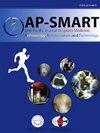腹压运动和三头肌过度活动时冈下肌、三角肌前、后纤维的肌电图比较
IF 1.4
Q3 ORTHOPEDICS
Asia-Pacific Journal of Sport Medicine Arthroscopy Rehabilitation and Technology
Pub Date : 2025-09-04
DOI:10.1016/j.asmart.2025.08.004
引用次数: 0
摘要
背景/目的腹压练习(BPE)是一种重要的临床工具,但其效果取决于正确的执行。本研究旨在阐明区分适当的BPE和以代偿性肩部伸展为特征的不适当的BPE的肌肉激活模式。我们假设一个合适的模式将包括更大的后三角肌激活来稳定,而不合适的模式将显示肱三头肌活动增加。方法采用表面肌电记录15例健康男性冈下肌、三角肌前肌、三角肌后肌和肱三头肌长头肌的活动。样本量基于先前的类似调查(例如,[13,19])。在三种不同的负荷条件下(体重的2%、5%和10%),比较了两种情况下的肌肉激活情况:适当的模式(孤立的内旋)和不适当的模式(内旋加肩部伸展10°)。结果在所有负载条件下,在适当的模式下,后验三角肌活动明显更高。相反,肱三头肌活动在不适当的模式下明显更高,特别是在5%和10%的负荷条件下。三角肌前肌和冈下肌在不同类型间无显著差异。结论后三角肌在适当的肩关节伸展中起着关键的稳定作用,而肱三头肌长头过度活动是代偿性肩部伸展的明确指标。这些发现为临床医生提供了监测BPE形式的循证标记物,以确保其治疗效果和安全性。本文章由计算机程序翻译,如有差异,请以英文原文为准。
Electromyographic comparison of infraspinatus, anterior, and posterior deltoid fibres during belly press exercise and triceps overactivity
Background/objective
The Belly Press Exercise (BPE) is a key clinical tool, but its efficacy is dependent on proper execution. This study aimed to clarify the muscle activation patterns that differentiate a proper BPE from an inappropriate pattern characterized by compensatory shoulder extension. We hypothesized that an appropriate pattern would involve greater posterior deltoid activation for stabilization, while the inappropriate pattern would show increased triceps brachii activity.
Methods
Surface electromyography was used to record the activity of the infraspinatus, anterior deltoid, posterior deltoid, and long head of the triceps brachii in 15 healthy male participants. The sample size was based on prior similar investigations (e.g., [13, 19]). Muscle activation was compared between two conditions: an appropriate pattern (isolated internal rotation) and an inappropriate pattern (internal rotation with 10° of shoulder extension) under three different load conditions (2, 5, and 10 % of body weight).
Results
Posterior deltoid activity was significantly higher in the appropriate pattern across all load conditions. In contrast, triceps brachii activity was significantly higher in the inappropriate pattern, particularly under the 5 % and 10 % load conditions. No significant differences were observed for the anterior deltoid or infraspinatus between patterns.
Conclusion
The posterior deltoid acts as a key stabilizer during a proper BPE, while overactivity of the long head of the triceps brachii is a clear indicator of compensatory shoulder extension. These findings provide clinicians with evidence-based markers for monitoring BPE form to ensure its therapeutic efficacy and safety.
求助全文
通过发布文献求助,成功后即可免费获取论文全文。
去求助
来源期刊
CiteScore
3.80
自引率
0.00%
发文量
21
审稿时长
98 days
期刊介绍:
The Asia-Pacific Journal of Sports Medicine, Arthroscopy, Rehabilitation and Technology (AP-SMART) is the official peer-reviewed, open access journal of the Asia-Pacific Knee, Arthroscopy and Sports Medicine Society (APKASS) and the Japanese Orthopaedic Society of Knee, Arthroscopy and Sports Medicine (JOSKAS). It is published quarterly, in January, April, July and October, by Elsevier. The mission of AP-SMART is to inspire clinicians, practitioners, scientists and engineers to work towards a common goal to improve quality of life in the international community. The Journal publishes original research, reviews, editorials, perspectives, and letters to the Editor. Multidisciplinary research with collaboration amongst clinicians and scientists from different disciplines will be the trend in the coming decades. AP-SMART provides a platform for the exchange of new clinical and scientific information in the most precise and expeditious way to achieve timely dissemination of information and cross-fertilization of ideas.

 求助内容:
求助内容: 应助结果提醒方式:
应助结果提醒方式:


